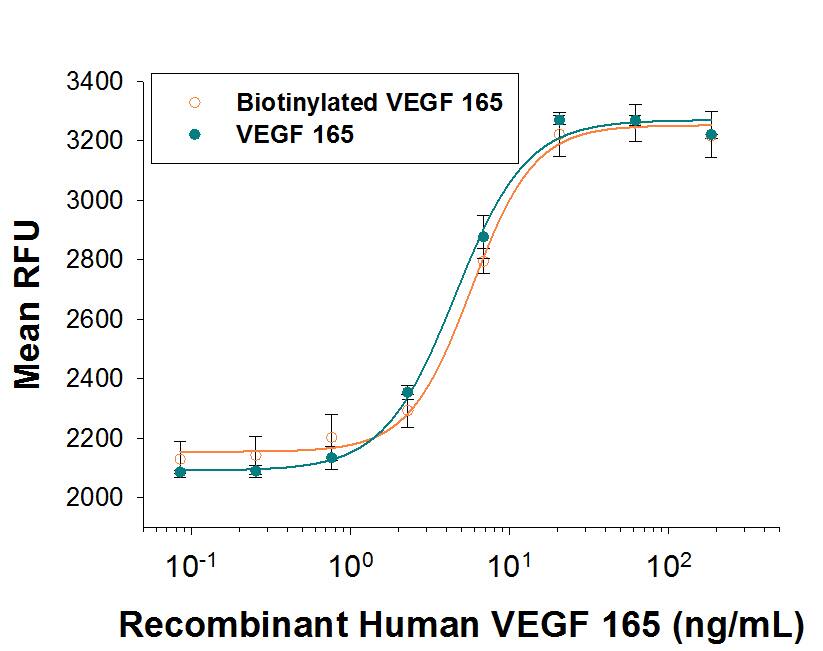Recombinant Human VEGF 165 Biotinylated Protein, CF
R&D Systems, part of Bio-Techne | Catalog # BT293/CF

Key Product Details
Source
Sf 21 (baculovirus)
Accession #
Structure / Form
Disulfide-linked homodimer; Biotinylated protein via sugars
Conjugate
Biotin
Applications
Bioactivity
Product Specifications
Source
Spodoptera frugiperda, Sf 21 (baculovirus)-derived human VEGF protein
Ala27-Arg191
Ala27-Arg191
Purity
>95%, by SDS-PAGE visualized with Silver Staining and quantitative densitometry by Coomassie® Blue Staining.
Endotoxin Level
<0.10 EU per 1 μg of the protein by the LAL method.
Predicted Molecular Mass
19 kDa
Activity
Measured in a cell proliferation assay using HUVEC human umbilical vein endothelial cells. Conn, G. et al. (1990) Proc. Natl. Acad. Sci. USA 87:1323.
The ED50 for this effect is 1-6 ng/mL.
The ED50 for this effect is 1-6 ng/mL.
Scientific Data Images for Recombinant Human VEGF 165 Biotinylated Protein, CF
Both Biotinylated Recombinant Human VEGF 165 (Catalog # BT293/CF) and unlabeled Recombinant Human VEGF 165 (Catalog # 293-VE) stimulate HUVEC human umbilical vein endothelial cell proliferation. The ED50 for this effect is 1-6 ng/mL. The similarity in activity highlights that the biotinylayed protein is fully functional.
Formulation, Preparation and Storage
BT293/CF
| Formulation | Lyophilized from a 0.2 μm filtered solution in Acetonitrile and TFA. |
| Reconstitution | Reconstitute at 100 μg/mL in 4 mM HCl. |
| Shipping | The product is shipped at ambient temperature. Upon receipt, store it immediately at the temperature recommended below. |
| Stability & Storage | Use a manual defrost freezer and avoid repeated freeze-thaw cycles.
|
Background: VEGF
References
- Leung, D.W. et al. (1989) Science 246:1306.
- Keck, P.J. et al. (1989) Science 246:1309.
- Robinson, C.J. and S.E. Stringer (2001) J. Cell. Sci. 114:853.
- Vempati, P. et al. (2014) Cytokine Growth Factor Rev. 25:1.
- Byrne, A.M. et al. (2005) J. Cell. Mol. Med. 9:777.
- Nowak, D.G. et al. (2008) J. Cell Sci. 121:3487.
- Pan, Q. et al. (2007) J. Biol. Chem. 282:24049.
- Goel, H.L. and A.M. Mercurio (2013) Nat. Rev. Cancer 13:871.
- Carvalho, J.F. et al. (2007) J. Clin. Immunol. 27:246.
- Angelo, L.S. and R. Kurzrock (2007) Clin. Cancer Res. 13:2825.
Long Name
Vascular Endothelial Growth Factor
Alternate Names
MVCD1, VAS, Vasculotropin, VEGF-A, VEGFA, VPF
Entrez Gene IDs
Gene Symbol
VEGFA
UniProt
Additional VEGF Products
Product Documents for Recombinant Human VEGF 165 Biotinylated Protein, CF
Product Specific Notices for Recombinant Human VEGF 165 Biotinylated Protein, CF
For research use only
